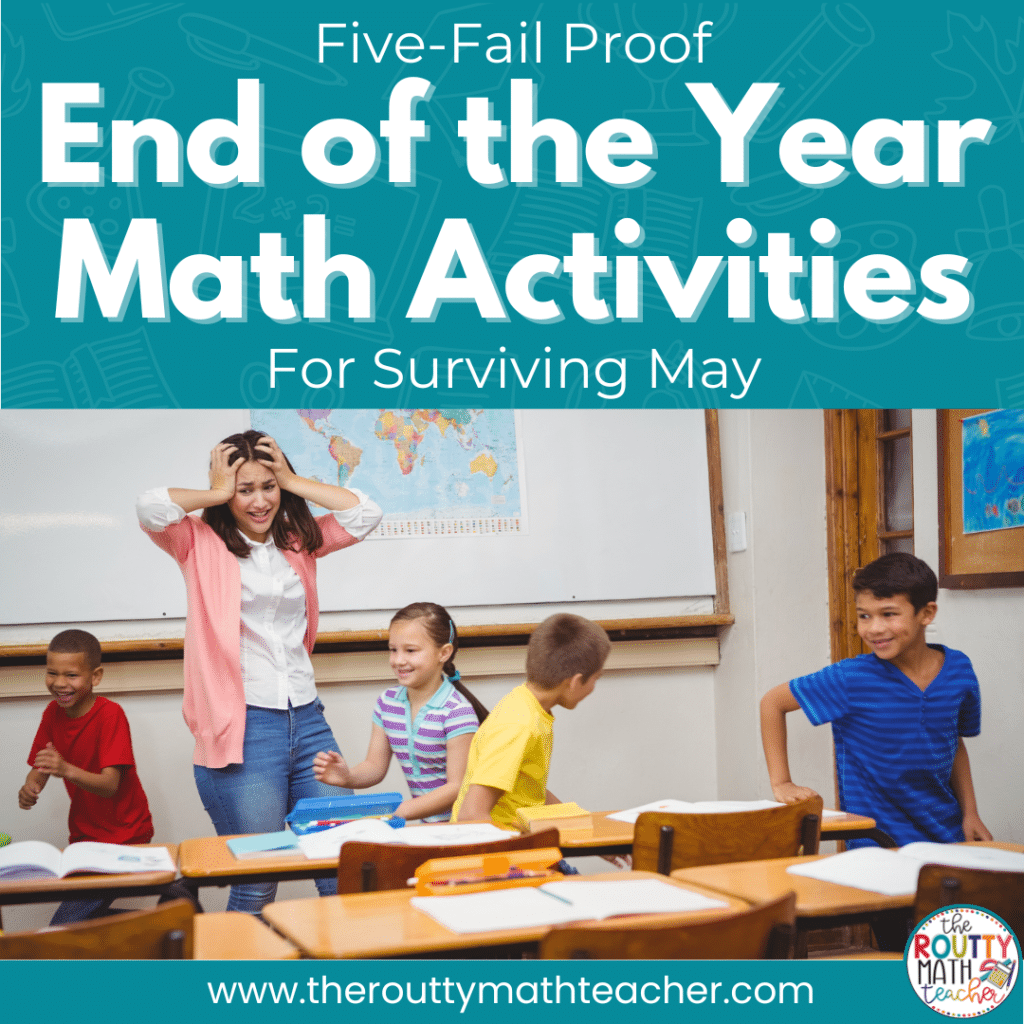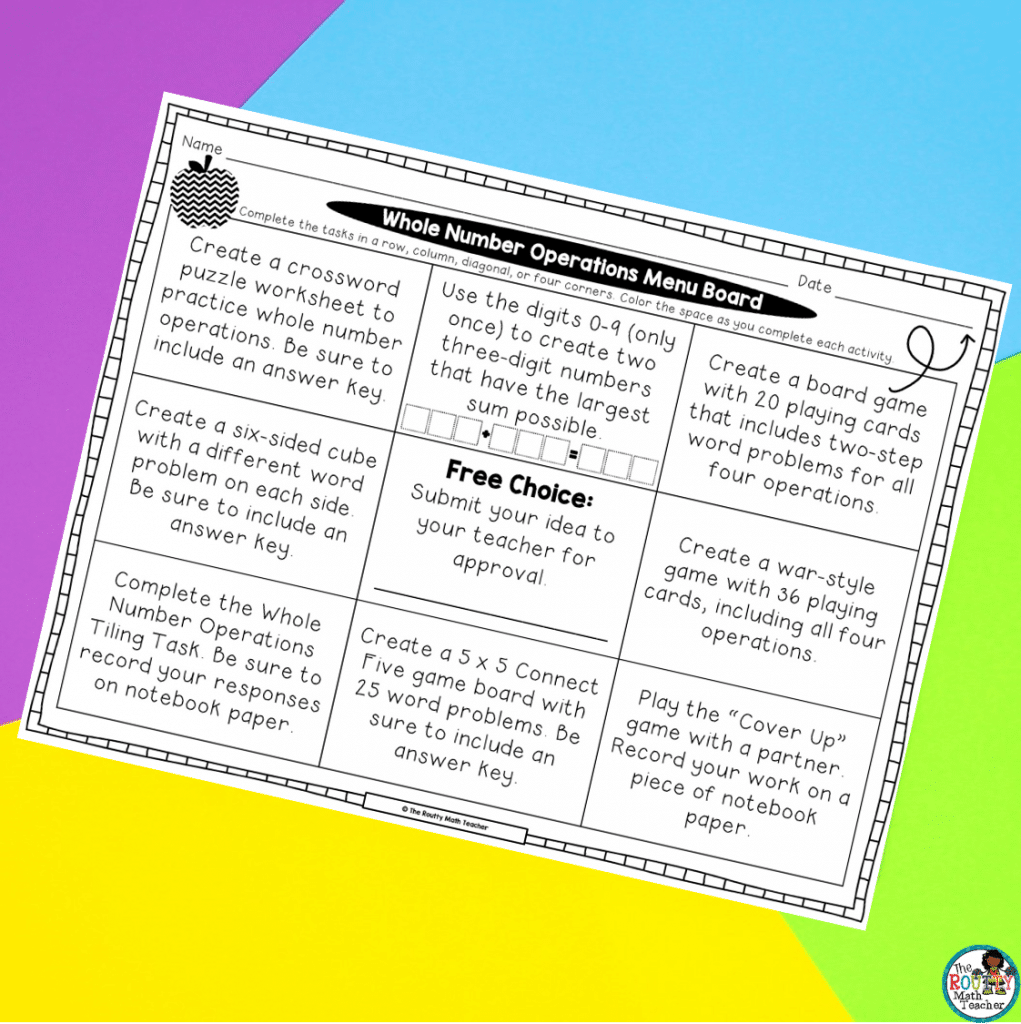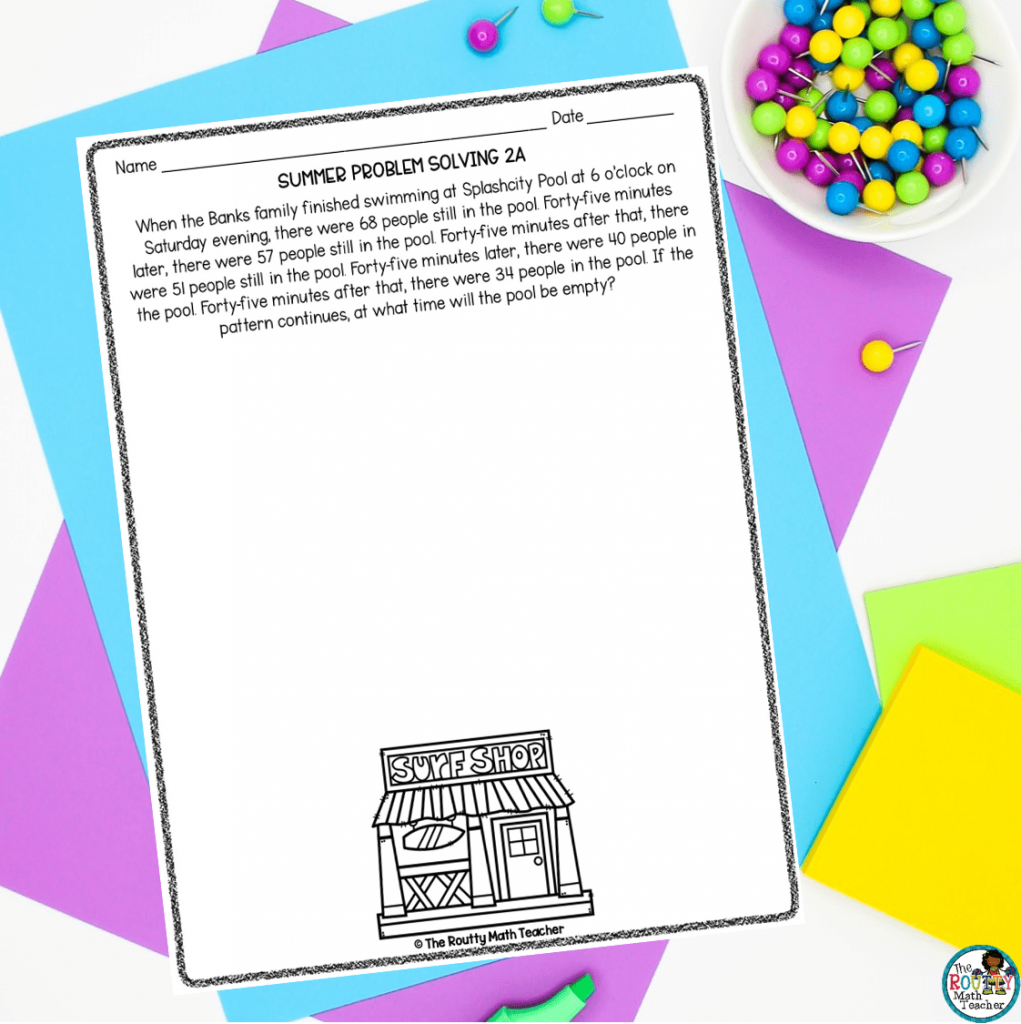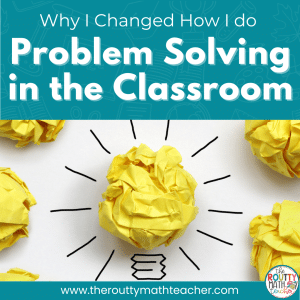The last days and weeks of school are always the hardest. The kids are done and we’re tired– a terrible combination. Over the years, I found increasing the rigor during this time keeps my students busy and keeps me from running out screaming. In this post, I share five of my tried-and-true end of the year math activities for keeping students engaged at the end of the school.
Me: “We’re finished with the math lesson. You have about 20 minutes before specials. Once you complete your assignment, you can have free time.”
Student: “We can do anything we want?”
Me: “Yes, as long as no one gets hurt and you don’t break any laws or school rules.” 😁
—
This is me after we finish the state test in May. It’s my reward to myself after the late nights planning and teaching content at warp speed all year.
I’m sure you’re reading this with shock on your face thinking you could never let your students do whatever they want to do and get away with it.
I hear you.
But, we all know teaching during the last weeks of the year is hard— really hard.
However, with a little planning and creativity, the craziest weeks of the year can become the most engaging.
How to Survive May
In my own classroom, I plan a different critical thinking challenge for each day of the week. The students then spend most of their math time exploring the tasks, devising a plan to solve them, and then finding the solution. We also spend time reviewing content that would be most helpful for the next grade level, usually fraction, decimal, and whole number operations.
Those are some of the strategies I use to keep students engaged. Keep reading for more of my tried and true end-of-the-year math activities to keep students engaged during the last days of school.
End of the Year Math Activities
Activity 1: Year-in-Review Products
This activity is super fun and requires almost no prep work! It also takes several days to complete, so if you need some time to complete your end-of-the-year checklist, this is a great independent task for students. 😊
To complete the year-in-review, students create a game or activity to review one of the skills learned during the school year. Board games are simple to create and play, but there are other product ideas. See the list below for some examples of student-created and student-tested games.
- I Have, Who Has? Activity
- Crossword Puzzle (I use the Criss-cross puzzle maker at Discovery Education’s Puzzle Maker website.)
- Card Game
- Tic-Tac-Toe Board
- Problems or tasks on 6-sided cubes
- Dice Games
Each product should include an answer key and a set of detailed directions. Then, after all of the games and activities are complete, allow time for students to play each other’s games or complete the activities. This is the most valuable part of the activity because students LOVE sharing and playing each other’s games!
Technology Tip
Want to incorporate technology into your end-of-the-year math activities? Search the web for a Jeopardy template and allow students to create a Jeopardy game for one topic or skill. After students complete the game, arrange a time for small groups of students to play each of the Jeopardy games.
Activity 2: Math Menus
It’s no secret I am a lover of math menus and have used them successfully for many years. One of the best things about using a menu at this time of year is students can complete them without much assistance. Creating the menu does take some time, but it can be used for days or even weeks once it’s complete.
Here’s how I create a menu:
- Decide on a topic. I then match the topic to a menu type. For topics that include several skills, such as whole number, fraction, and decimal operations, I use a more involved menu like a gameshow board or list menu. (Read more about menu types here.)
- I use product ideas, as well as materials and resources we used during the unit of instruction to fill the board. I’m strategic about what I place where. I want each student to have to demonstrate their knowledge with a variety of tasks, including practice and review, product creation, and critical thinking and problem-solving. Read more about product creation here.
- I also offer an opportunity for students to submit their own product creation ideas. Students love this because it provides an additional layer of differentiation and creativity.
- I create instruction sheets for all of the products. I also compile all necessary materials in a central location so students have access to any materials they need.
- After I create the menu, I review it with the students and allow them to ask questions before setting them loose to work on their own.
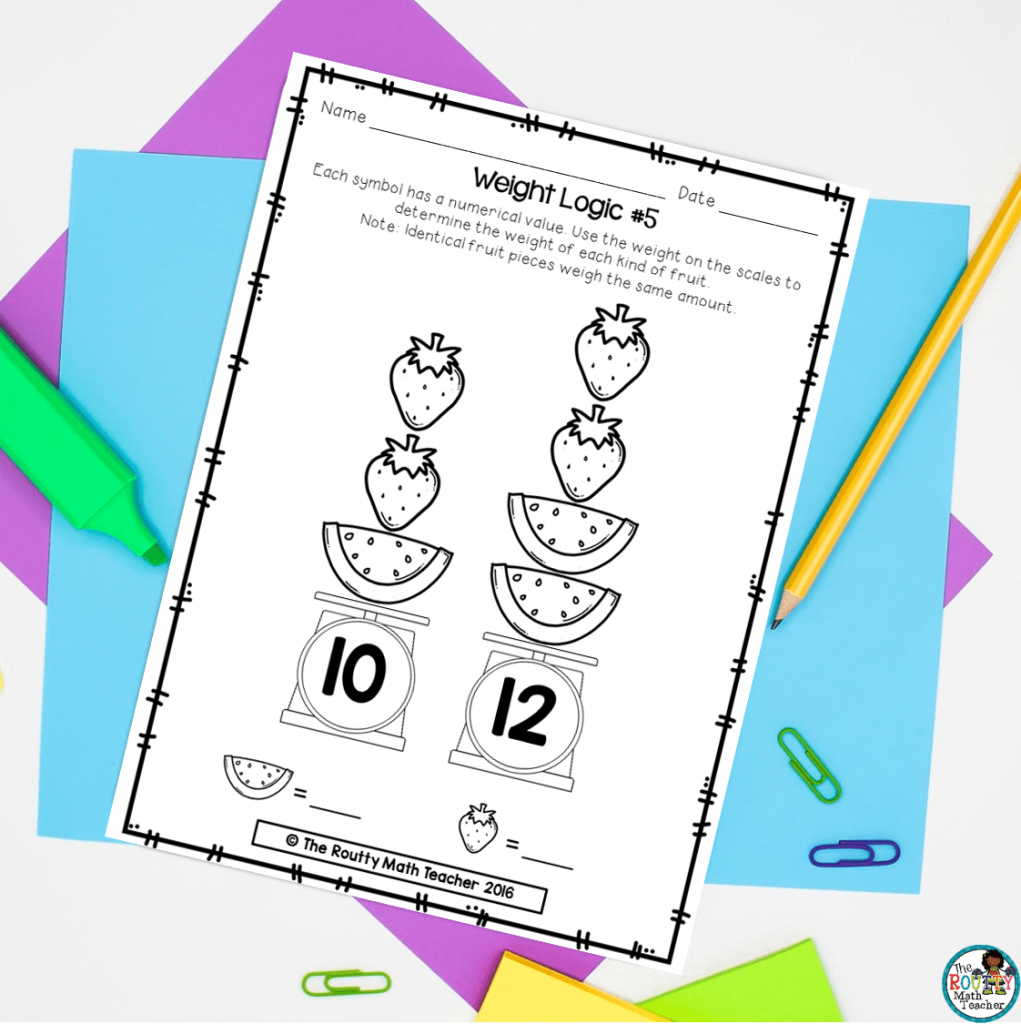
Activity 3: Weight Logic
This is one of my favorite challenges! Logic puzzles help students develop solid critical thinking and problem-solving skills. To complete the weight logic puzzles, students use the sum of the symbols shown on the scale to determine the value of each symbol.
For many students, this task seems simple. You guess and check the values until you find a combination that works. But that level of thinking is just the beginning. The real thinking comes in when students use strategies, other than guess and check, to determine the value of each fruit.
For example, if we look at the puzzle above, when students recognize the watermelon and two strawberries on the left side are included in the two pieces of watermelon and two strawberries on the right side, they can subtract the 10 on the left from the 12 on the right to see the leftover watermelon slice has a value of 2. Once they know that, they can determine the value of the strawberry. How’s that for fostering algebraic thinking in elementary school!
It will take time for students to arrive at the solutions. Once they’ve mastered the guess and check strategy, encourage them to look for other ways to solve the problem. And, be sure to have students share their solution strategies with other classmates as well.
Get your free copy of “Fruit Logic” using the form at the bottom of this post.
Activity 4: Boggle Math
The next activity is called Moggle—similar to the traditional Boggle game except students create number sentences instead of words. What I love about this activity is it can be used for several days because students keep challenging themselves to find new combinations of numbers that will create a number sentence.
This activity is a great way to differentiate for students because the length of the number sentences they create is based on their individual ability and understanding of the task. This activity can also be transformed into a whole-class game where teams of students compete to create number sentences and then earn points based on the length of the sentence.
Read more about Moggle and grab a free set of challenges here.
Activity 5: Problem Solving Challenges
If you’ve been a reader of this blog for any length of time, you know I love problem-solving! Specifically, I want to focus on non-routine problem-solving challenges. These are my favorite types of problems to use in the classroom; however, they do require more time to allow students to understand and then solve them.
Non-routine problems are ones that cannot be solved by adding, subtracting, multiplying, or dividing to find the answer. They require students to develop and execute a plan of action and can often have more than one solution.
My Problem Solving Process
I love to find a really good one—one which will take some time to complete and one where the solution is not easily determined. Then, I divide students into small groups of 2 – 3 (more than three students in a group creates opportunities for disengagement).
I give each group a problem-solving challenge, a tub of markers, and a piece of large paper, like construction paper or an old textbook cover. Once students have their materials, they read the problem, determine a solution strategy, and create a poster to illustrate the answer.
After all of the groups have completed the task, I have each group display their poster and do a gallery walk to review how other groups solved the problem. Once the students have viewed the posters, we come back together as a whole group and I use math talk to discuss the problem.
Here are some of the questions I ask during math talk:
- How can you decide if an answer is reasonable or not? What would be an example of an answer which is too high? Too low?
- What’s the most effective strategy? Why?
- What’s the most efficient strategy? Why?
- What if a group thought about it this way ________________________ (provide an erroneous solution strategy)? How could you help them get on the right path?
I’m Ready to Save My Sanity!
Keeping students engaged during the last few days and weeks of the school year is the key to reducing discipline problems and retaining our sanity. It may even prevent us from wanting to count down the days. Well, not really, but you understand what I mean. If you’re looking for new ideas, give these end-of-the-year math activities a try for a smooth, engaging, and fun end to the school year.
Sound Off!
How do you survive the last weeks of school?

